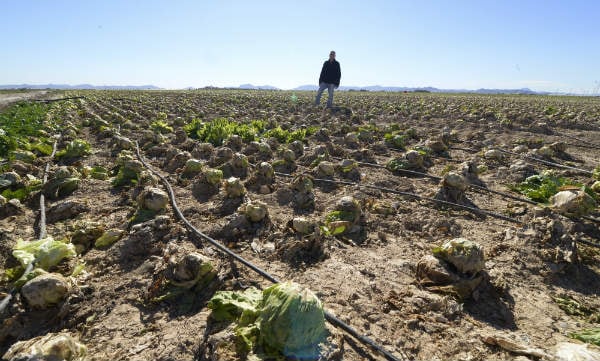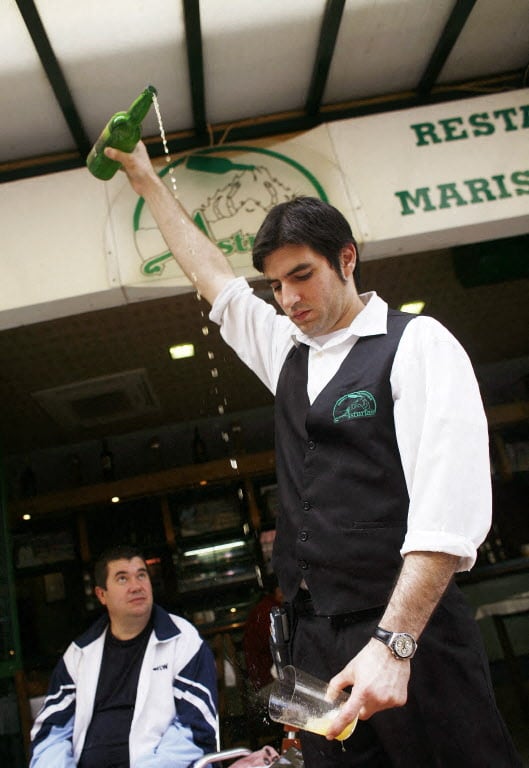Courgette prices are soaring, but shoppers are also thinking twice before shelling out for pricier tomatoes, peppers and aubergines.
Some British supermarkets have even resorted to rationing sales of broccoli and lettuce in light of plummeting harvests.
Spanish supermarkets secretly hoarding massive stockpiles of vegetables https://t.co/iJKm3iPvD9 pic.twitter.com/1Y7smL6TOJ
— The Sun (@TheSun) February 6, 2017
The vast fields along Spain's Mediterranean coast usually stay warm enough to produce year-round, even in winter.
But torrential rains hit the region late December, followed by shock snowfalls in January – areas near Murcia, in the heart of the farming zones, had not seen a snowflake in 34 years.
For most of the year, Spain supplies around 30 percent of the main fresh fruits and vegetables on European shelves. In winter, this proportion rises to half – and to a whopping 80 percent when it comes to lettuce.
After the bad weather hit, a Spanish federation of agricultural exporters reported a 30-percent drop in European shipments. The COAG farmers' union says output has halved in the worst-hit regions.
Some farmers “have lost their entire crop”, said Andres Gongora, COAG'S Almeria director.
The province of Murcia, which exports two-thirds of Spanish lettuce, a trade worth €423 million ($450 million), has been particularly hit. Young lettuces, growing in open fields after sprouting from seeds in greenhouses, were destroyed. After the foul weather receded, a thick coat of thawed mud held up replanting in many places.
“We won't be able to plant here this year,” said Javier Soto, manager of spinach and melon growers Agrar Systems near the town of Murcian town of Torre Pacheo, pointing to a field gouged out by a muddy torrent.
Adding to the veggie crunch has been heavy snowfall in northern Italy, another major supplier to Europe.
Thousands of growers there have lost their crops, with expected losses of to around €400 million euros, according to Italy's main farmers' union.
Luxury lettuce
The double whammy is now being felt in European stores.
Lettuce prices have doubled in Germany, and even tripled in Finland. In France, courgettes fetched four to five times their normal price in mid-January.
Spanish supplies of iceberg, romaine and other types of lettuce had already been hit by a dry autumn, and artichoke harvests had fallen by a fourth.
Many shoppers have vented their anger on social media, using hashtags like #lettucecrisis and #courgettecrisis.
Laureano Montesinos, a marketing director at Fruveg, a producer near Murcia, said British supermarket chains had not immediately grasped how dire the situation was.
In Germany and northern Europe, produce stalls are not as packed as usual, but stores have managed to avoid drastic measures.
“We've had some supply problems with iceberg lettuce these past weeks. But until now, we've been able to offer enough for our clients”, said Kirsten Gess, communications director for the Aldi-Sud discount chain.
Spain's agriculture minister expects production to recover in a few weeks, with producers aiming to be back on track by early March.
But for lettuce grown in open fields, the wait could extend into April.
For Alan Clarke, a strategist at Scotiabank in London, the price increases could spill over into processed food products, such as veggie burgers and other ready-to-eat meals.
“More generally, restaurant prices face upside risks, especially because spring/summer menus are due for imminent update”, he added.
So even though higher produce prices may prove short-lived once Spain's harvests recover, diners may be paying the bill for months.
By AFP's Emmanuelle Michel





 Please whitelist us to continue reading.
Please whitelist us to continue reading.
Member comments